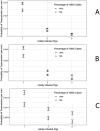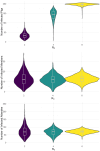Estimating the risk of zoonotic transmission of swine influenza A variant during agricultural fairs in the United States: a mathematical modeling
- PMID: 40235572
- PMCID: PMC11997979
- DOI: 10.3389/fvets.2025.1523981
Estimating the risk of zoonotic transmission of swine influenza A variant during agricultural fairs in the United States: a mathematical modeling
Abstract
Introduction: Agricultural fairs offer a unique interface between humans and swine. We investigate the transmissibility of influenza A variant from pigs to humans using epidemiological data from a 2011 zoonotic outbreak of an influenza H3N2 variant during an agricultural county fair in Pennsylvania.
Methods: We developed a mathematical model for the transmission of a swine influenza pathogen among pigs and humans at an agricultural fair. We fitted our model to the outbreak data to estimate zoonotic transmissibility. We considered nine data-driven scenarios of swine-to-swine basic reproductive number (R0) and the number of infected pigs at the start of the fair, and we simulated the zoonotic outbreak dynamics.
Results: We estimated the probability of swine-to-human H3N2v transmission per minute of swine contact for which our model best fitted the data. The probability of transmission of H3N2v per minute of contact with swine among club members was estimated to vary from 0.029 (95% confidence interval (CI): 0.028-0.030), when R0 = 2 with 1 initially infected pig, to 0.00099 (0.00095-0.00102), when R0 = 6 with 5 initially infected pigs. For attendees, we showed that the probability equals 0.0168 (95% CI: 0.0167-0.0169), when R0 = 2 with 1 initially infected pig, and 0.00371 (95% CI: 0.00368-0.00373), when R0 = 2 with 5 initially infected pigs. For all scenarios, we estimated H3N2v infection prevalence among club members and attendees to average 12 and 0.7%, respectively.
Discussion: These results show that the transmission risk may vary substantially between club members and attendees and with the underlying disease transmission among pigs. Although fair attendees may have a small transmissibility risk, annual fair attendees represent a large population likely to experience zoonotic events and facilitate the emergence of a potential pandemic influenza variant.
Keywords: agricultural fair; mathematical modeling; swine influenza; transmission risk; zoonotic events.
Copyright © 2025 Pittman Ratterree, Chitlapilly Dass and Ndeffo-Mbah.
Conflict of interest statement
The authors declare that the research was conducted in the absence of any commercial or financial relationships that could be construed as a potential conflict of interest. The author(s) declared that they were an editorial board member of Frontiers, at the time of submission. This had no impact on the peer review process and the final decision.
Figures




Similar articles
-
Evaluating preventive measures for the zoonotic transmission of swine influenza A variant at agricultural fairs in the United States: a mathematical modeling study.Front Vet Sci. 2025 May 30;12:1590156. doi: 10.3389/fvets.2025.1590156. eCollection 2025. Front Vet Sci. 2025. PMID: 40520433 Free PMC article.
-
Transmissibility of variant influenza from Swine to humans: a modeling approach.Clin Infect Dis. 2013 Jul;57 Suppl 1(0 1):S16-22. doi: 10.1093/cid/cit303. Clin Infect Dis. 2013. PMID: 23794727 Free PMC article.
-
Aerosol Transmission from Infected Swine to Ferrets of an H3N2 Virus Collected from an Agricultural Fair and Associated with Human Variant Infections.J Virol. 2020 Jul 30;94(16):e01009-20. doi: 10.1128/JVI.01009-20. Print 2020 Jul 30. J Virol. 2020. PMID: 32522849 Free PMC article.
-
Are pigs overestimated as a source of zoonotic influenza viruses?Porcine Health Manag. 2022 Jun 30;8(1):30. doi: 10.1186/s40813-022-00274-x. Porcine Health Manag. 2022. PMID: 35773676 Free PMC article. Review.
-
The Reproduction Number of Swine Viral Respiratory Diseases: A Systematic Review.Vet Sci. 2024 Jul 2;11(7):300. doi: 10.3390/vetsci11070300. Vet Sci. 2024. PMID: 39057984 Free PMC article. Review.
Cited by
-
Evaluating preventive measures for the zoonotic transmission of swine influenza A variant at agricultural fairs in the United States: a mathematical modeling study.Front Vet Sci. 2025 May 30;12:1590156. doi: 10.3389/fvets.2025.1590156. eCollection 2025. Front Vet Sci. 2025. PMID: 40520433 Free PMC article.
References
-
- Rose N, Hervé S, Eveno E, Barbier N, Eono F, Dorenlor V, et al. . Dynamics of influenza a virus infections in permanently infected pig farms: evidence of recurrent infections, circulation of several swine influenza viruses and reassortment events. Vet Res. (2013) 44:72. doi: 10.1186/1297-9716-44-72, PMID: - DOI - PMC - PubMed
LinkOut - more resources
Full Text Sources

